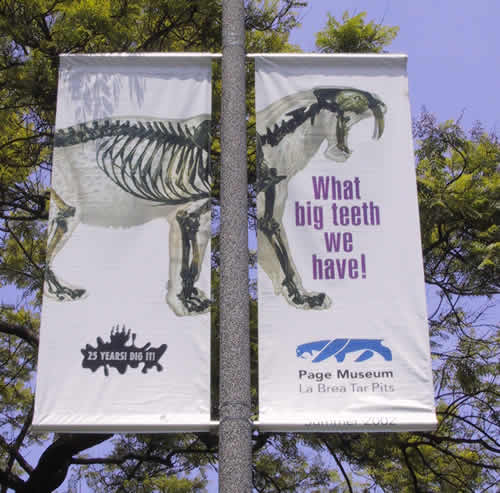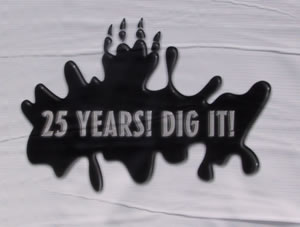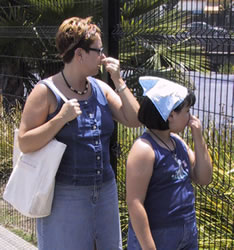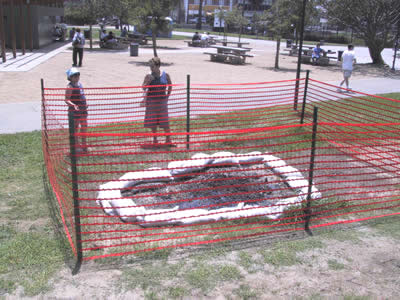
 The
George C. Page Museum at the La Brea Tar Pits - Los Angeles,
CA
The
George C. Page Museum at the La Brea Tar Pits - Los Angeles,
CA
July
14, 2002: We need new shopping centers in Los Angeles.
That is, if you believe the latest trend.
Big
shopping malls have sprung up in the past few months,
and more are on the way. Hollywood & Highland, Hollywood
& Vine, The Grove at Farmers Market, The Arclight
Cinerama Dome, Paseo Colorado -- all of them feature fantasy
architecture, open-air walkways, and the latest lineup
of stores -- Gap, Structure, Abercrombie and Fitch, Hot
Topic, J.Crew, Starbucks, Tommy Bahama, Sam Goody Music
and a large multiplex of movie theaters.
The
way we're expected to go out and shop here in Southern
California, you'd never guess the economy is sinking.
These new places are impressive to look at, and they've
become bona fide gathering places and tourist attractions.
Not
far from all this glitz and commerce, right there on Wilshire
Blvd.'s Miracle Mile, is what might be considered the
anithesis of those plush new shopping destinations --
The La Brea Tar Pits. A tourist staple for 70+ years,
people seem to enjoy congregating at this somewhat peculiar
location. In fact, the day we visited, they were celebrating
their 25th anniversary of the George C. Page Museum.
We
didn't know about the special event, but the hundreds
who were enjoying the face painting, personal appearances,
live music, food and other entertainment, did know about
it, and seemed to be having a good time. Because of the
extra crowds, parking was limited. The museum's own parking
lot off of Curson Avenue was full, so we back tracked
and used the alternate parking in Museum Row.
The
George C. Page Museum was built in 1977 to pull together
all of the various fossils, bones, and exhibits that had
been collected over the years - many of which have been
excavated from the various La Brea Tar Pits.
A
few things to clear up.
The
La Brea Tar Pits It's a bizarre centerpiece
for a museum, or even a public gathering spot. Sitting
in Hancock Park [and within walking distance from Los
Angeles County Museum of Art], it's a very popular place.
[Please note: La Brea is Spanish for 'The Tar.' So, as
Megan pointed out, when translated, we're going to 'The
The Tar Tar Pits.']

 Tar
Pits Yes, there are pits filled with tar, or
liquid asphalt. The main pit faces Wilshire Blvd. and
is the most prominent both in size and smell.
Tar
Pits Yes, there are pits filled with tar, or
liquid asphalt. The main pit faces Wilshire Blvd. and
is the most prominent both in size and smell.
About
the size of a football field, it's filled with the gooey
mess -- it's dark and bubbly and has a strange tart smell
due to the methane gas that is expelled. Not necessarily
foul or noxious, but on the hot day that it was, it's
pretty pungent. [left]
The
other pits around the area are smaller, and drier, and
are still in use -- paleontologists are still bringing
forth fossils from an excavation that began in 1969. Tar
even continues to bubble up in unexpected places. [below]

Dinosaurs
On our Museum Madness schedule, I wrote 'Dinosaurs,
Fossils and Tar Pits -- oh my!' Wrong, Jim. No dinosaurs
here, we learned. Instead, the bones, fossils and remnants
showcased here are of prehistoric mammals that roamed
the area 14,000 years ago. Saber-tooth cats, wooly mammoths,
dire wolves, and even a La Brea Woman. More 'Ice Age'
than 'Jurassic Park.'

George
C. Page Add him to the list of Southern California
entrepreneurs who got involved in museums. As a young
man living in Nebraska, Page took a bite out of a California
orange. It impressed him so much, he moved to California
and started a business where he would package and ship
California oranges to impressed mid-Westerners. From that,
he developed a successful series of businesses and went
on to philanthropic endeavors. Which included the museum
that was built 25 years ago.
Okay,
class, are we ready to see the museum?



